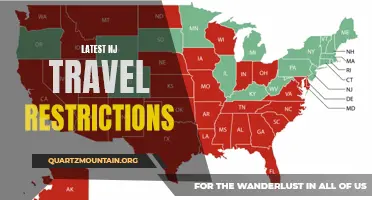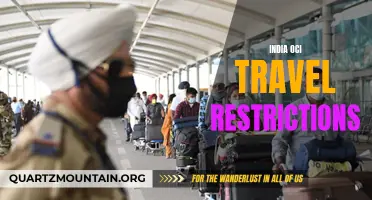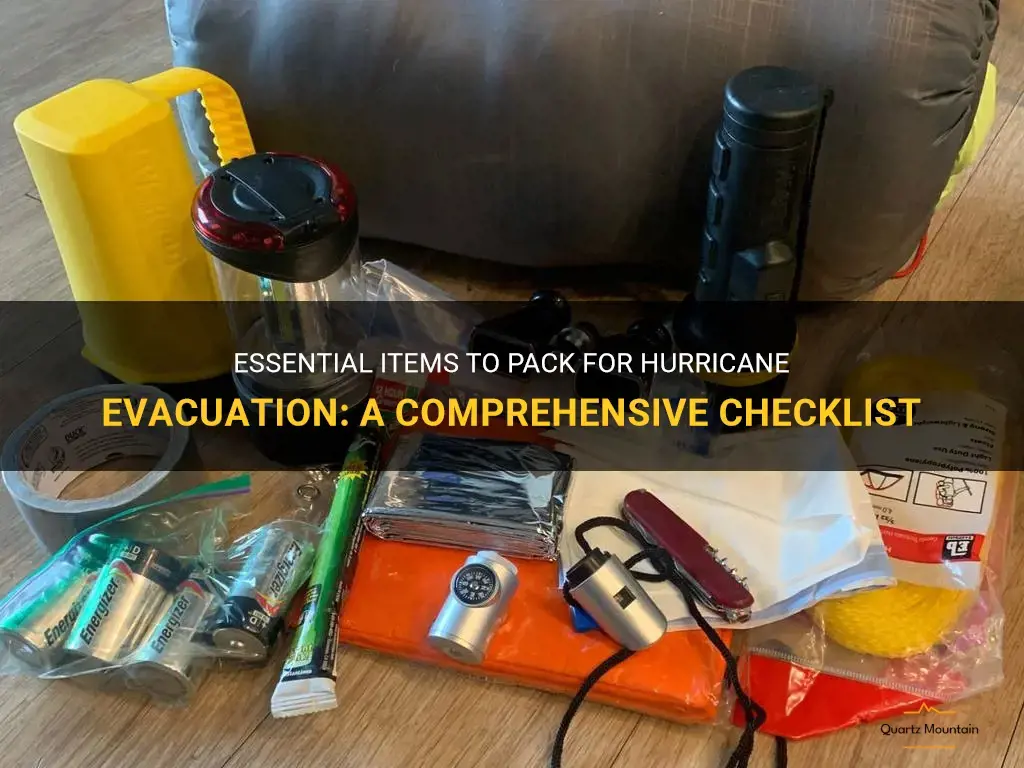
Hurricane season brings with it a sense of urgency and the need to be prepared. When a hurricane is approaching, one of the most important things to do is evacuate to a safer location. However, packing for a hurricane evacuation can be overwhelming, especially when you're trying to remember everything you might need in case of emergency. That's why we've compiled a comprehensive checklist of essential items to pack for a hurricane evacuation. From basic necessities like food and water to important documents and personal hygiene items, this checklist will ensure that you have everything you need to stay safe and comfortable during a hurricane evacuation. So, before the storm hits, take a few moments to review this checklist and make sure you're prepared for whatever the hurricane may bring.
| Characteristic | Value |
|---|---|
| Food | Non-perishable items |
| Water | At least 1 gallon per person per day for at least 3 days |
| Medications | At least a 7-day supply |
| Documents | Important documents such as ID, passports, insurance information |
| Clothing | Weather-appropriate clothing and extra undergarments |
| First aid supplies | Basic first aid kit with bandages, antiseptic, and medications |
| Personal hygiene items | Soap, toothbrush, toothpaste, toilet paper |
| Cash and credit cards | Enough cash and a credit card for emergency expenses |
| Flashlight and batteries | A flashlight with extra batteries |
| Cell phone chargers | Chargers for all devices you may need to stay in contact |
| Radio | Battery-powered or hand-crank radio |
| Portable power bank | To charge electronic devices when there is no electricity |
| Blankets and pillows | To stay warm and comfortable during the evacuation |
| Pet supplies | Food, water, leash, carrier, and any medications for your pet |
| Important contact numbers | Emergency contacts and contacts for insurance and healthcare providers |
| Tools and supplies | Multi-tool, duct tape, and any other tools you may need |
| Maps and local information | Maps of the area and information about shelters and evacuation routes |
| Entertainment | Books, games, and activities to keep yourself and your family occupied |
| Extra set of car keys | In case you lose your original set during the evacuation |
| Portable phone charger | Charging cable and power bank for your phone |
| Whistle | For signaling for help if necessary |
| Disposable plates and utensils | In case you don't have access to a kitchen during the evacuation |
What You'll Learn
- What are the essential items to pack when evacuating for a hurricane?
- How much non-perishable food should I pack for a hurricane evacuation?
- Is it important to pack a first aid kit when evacuating for a hurricane?
- Should I bring extra batteries and a portable phone charger in case of loss of power during a hurricane evacuation?
- What clothing and personal hygiene items should I include in my evacuation packing list for a hurricane?

What are the essential items to pack when evacuating for a hurricane?
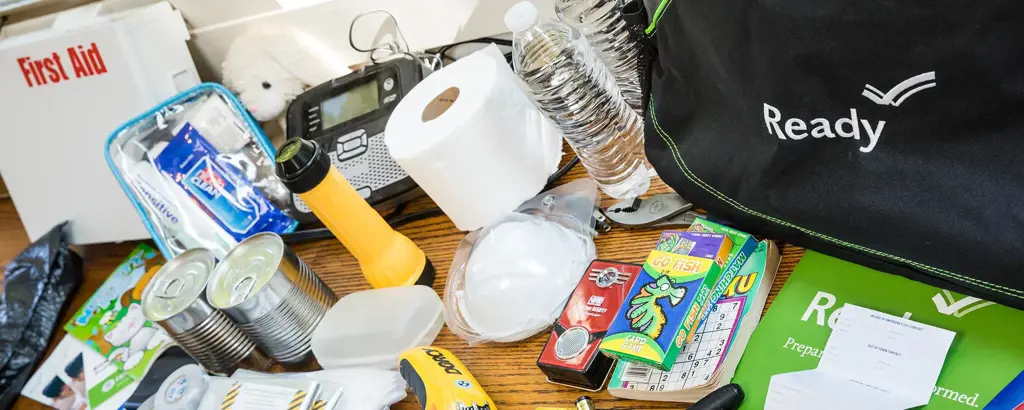
When preparing to evacuate for a hurricane, it is essential to pack the right items to ensure your safety and well-being. While the specific needs may vary depending on individual circumstances, there are some essential items that should be included in every hurricane evacuation kit.
- Water and Non-Perishable Food: Pack at least one gallon of water per person per day for a minimum of three days. Additionally, include non-perishable food items that do not require cooking or refrigeration, such as canned goods, energy bars, and dried fruits. Remember to pack a manual can opener as well.
- Medications and First Aid Supplies: Pack a sufficient supply of prescription medications for each family member, along with any necessary medical equipment or supplies. Additionally, include a basic first aid kit with items such as adhesive bandages, alcohol wipes, antiseptic ointment, and over-the-counter pain relievers.
- Personal Hygiene and Sanitation Items: Include essential toiletries such as soap, shampoo, toothpaste, toothbrushes, and toilet paper. Also, pack hand sanitizer, wet wipes, and garbage bags for proper waste disposal.
- Clothing and Bedding: Pack a change of clothes and comfortable footwear for each family member. Opt for lightweight, moisture-wicking fabrics suitable for the climate in your evacuation destination. Additionally, include blankets or sleeping bags for each person.
- Important Documents: Carry copies of important documents such as identification cards, passports, insurance policies, and medical records. It is recommended to keep these documents in a waterproof and portable container.
- Emergency Supplies: Include a flashlight with extra batteries, a battery-powered or hand-cranked radio, and a portable cellphone charger. Additionally, pack a whistle to signal for help and a multipurpose tool or Swiss Army knife.
- Cash and Credit Cards: Carry some cash in small denominations, as ATMs and electronic payment systems may not be available during a hurricane or its aftermath. Also, pack credit cards for emergencies.
- Basic Tools and Supplies: Include a set of basic tools such as a wrench, pliers, and a screwdriver. Additionally, pack duct tape, plastic tarps, and extra batteries for any electronic devices.
- Entertainment and Comfort Items: It is essential to pack items to keep yourself and your family entertained during the evacuation. Consider including books, games, puzzles, and comforting items such as stuffed animals or a favorite blanket.
- Pet Supplies: If you have pets, do not forget to pack their essentials as well. Include food, water, leash, collar, identification tags, medications, and any necessary pet carriers or crates.
Remember to regularly check and update your evacuation kit to ensure that all items are in good condition and suitable for use. Additionally, familiarize yourself with evacuation routes and emergency shelters in your area to ensure a smooth evacuation process. By packing these essential items, you can be better prepared and ensure the safety of yourself and your loved ones during a hurricane evacuation.
Essential Items to Include in Your Packing List for a Pigeon Forge Trip
You may want to see also

How much non-perishable food should I pack for a hurricane evacuation?
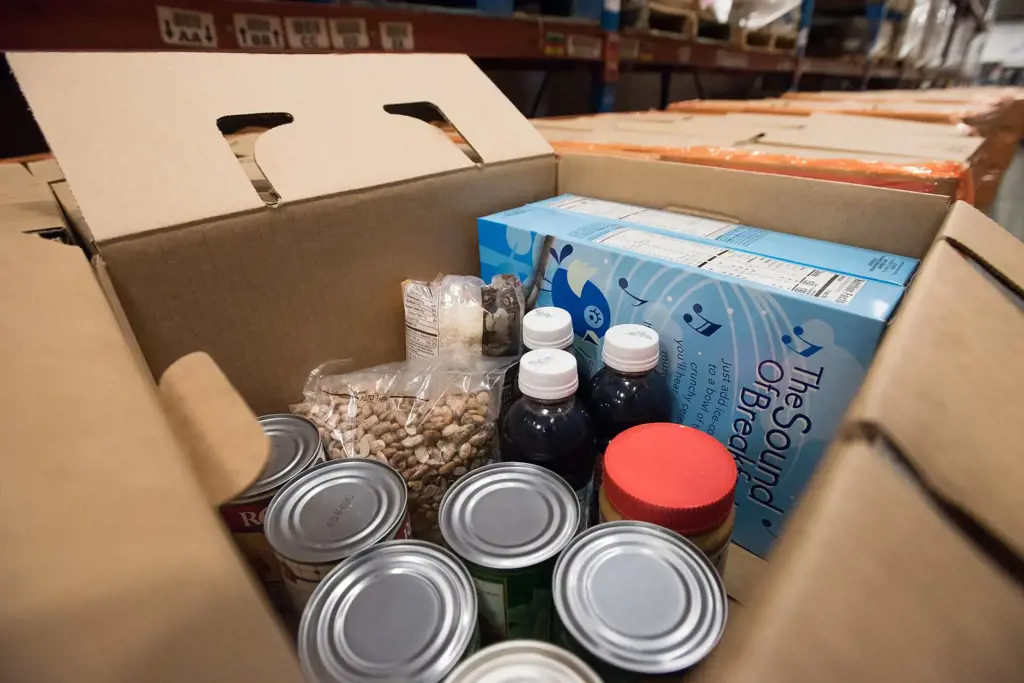
When preparing for a hurricane evacuation, it is important to plan ahead and ensure you have enough non-perishable food to sustain yourself and your family during the crisis. This article will guide you on how to determine the appropriate amount of non-perishable food you should pack for a hurricane evacuation.
Consider the Duration of the Evacuation:
The first step is to determine how long you may be away from your home. Hurricane evacuations can range from a few days to several weeks, depending on the severity of the storm and the extent of the damage. It is vital to have an estimate of the expected duration so you can plan accordingly.
Calculate the Daily Caloric Needs:
Next, you should calculate the daily caloric needs for each person in your household. The average adult requires about 2000 to 2500 calories per day to maintain their energy levels. However, this may vary depending on age, sex, and activity levels. It is crucial to account for individual differences when determining the amount of food needed.
Multiply the Daily Caloric Needs by the Number of Days:
After calculating the daily caloric needs, multiply it by the number of days you anticipate being away from home. For example, if you estimate a four-day evacuation and each person requires 2500 calories per day, the total number of calories needed for one person would be 10,000 calories (2500 x 4).
Choose Nutrient-Dense and Shelf-Stable Foods:
When selecting non-perishable food items, prioritize nutrient-dense options with a long shelf life. Examples include canned vegetables, beans, tuna, chicken, peanut butter, nuts, dried fruits, granola bars, and powdered milk. Aim for a variety of foods to ensure a well-balanced diet.
Consider Special Dietary Needs and Restrictions:
If you or any family members have special dietary needs or restrictions, such as allergies or medical conditions, make sure to account for those when packing your non-perishable food. Keep allergen-free alternatives and medications on hand if necessary.
Don't Forget Water:
In addition to non-perishable food, it is crucial to pack an adequate supply of water. The general recommendation is to have at least one gallon of water per person per day for drinking and sanitation purposes. It is essential to have enough clean water to stay hydrated during the evacuation period.
Pack Essential Supplies:
Remember to pack essential supplies such as can openers, utensils, plates, bowls, and napkins. These items will be necessary for consuming the non-perishable food you have packed. Additionally, include any necessary cooking equipment, such as a camping stove or portable grill, if you anticipate being able to cook during the evacuation.
By following these steps, you can determine the appropriate amount of non-perishable food to pack for a hurricane evacuation. It is always better to be prepared and have extra supplies on hand in case of unforeseen circumstances or extended evacuation periods. Stay safe during hurricane season by having a well-thought-out emergency plan in place.
Essential Items to Pack for Your Aspen Adventure
You may want to see also

Is it important to pack a first aid kit when evacuating for a hurricane?
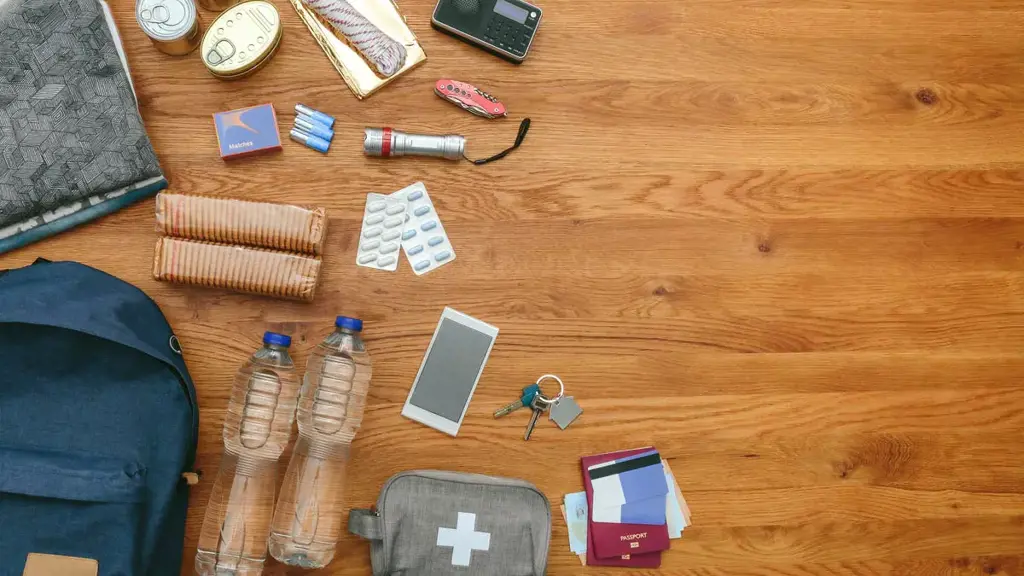
When preparing to evacuate for a hurricane, one of the most important items to pack is a first aid kit. Hurricanes can cause a wide range of injuries, including cuts, scrapes, and even more serious wounds. Having a first aid kit on hand can help provide immediate treatment and potentially save lives in emergency situations.
First and foremost, it is important to pack a first aid kit for hurricanes because of the potential for injuries. During a hurricane, debris can become airborne, causing cuts and lacerations. Additionally, strong winds and flooding can lead to accidents and falls, resulting in sprains and broken bones. By having a well-stocked first aid kit, you can quickly treat these injuries and reduce the risk of infection or further complications.
A basic first aid kit for hurricane evacuations should include essential items such as adhesive bandages, sterile gauze pads, adhesive tape, antiseptic wipes, antibiotic ointment, tweezers, scissors, and disposable gloves. These items can be used to clean wounds, stop bleeding, dress injuries, and provide temporary relief until medical professionals can be reached. It is also important to include any personal medications or prescriptions that may be needed during an evacuation.
In addition to the essential items, it is also recommended to pack items such as pain relievers, allergy medications, and insect repellent. Pain relievers can help alleviate discomfort caused by minor injuries or headaches, while allergy medications can provide relief from allergy symptoms that may be aggravated by the changing weather conditions. Insect repellent is important to protect against mosquito bites, which can transmit diseases such as Zika or West Nile virus.
Furthermore, having a first aid kit readily accessible during a hurricane evacuation can also provide peace of mind. In the event of an injury, knowing that you have the necessary supplies to provide immediate treatment can help alleviate stress and anxiety. It is also a good idea to familiarize yourself with basic first aid procedures and techniques in order to effectively use the items in your kit.
To emphasize the importance of packing a first aid kit for hurricane evacuations, let's consider an example. Sarah and her family live in a coastal area that is prone to hurricanes. They recently received a warning of an approaching hurricane and decided to evacuate to a safer location. Before leaving, Sarah packed a first aid kit with all the necessary supplies. While driving to the evacuation site, they encountered a fallen tree branch that caused a minor laceration on her daughter's arm. Sarah was able to quickly access the first aid kit and use the antiseptic wipes and adhesive bandages to clean and dress the wound. This immediate response prevented the risk of infection and assured their daughter's safety until they reached a medical facility.
In conclusion, packing a first aid kit when evacuating for a hurricane is of utmost importance. It ensures that you have the necessary supplies to treat and manage injuries that may occur during the chaotic and unpredictable nature of a hurricane. A well-stocked first aid kit can provide immediate relief, reduce the risk of complications, and potentially save lives. So, before you evacuate, make sure to include a first aid kit as part of your emergency preparedness plan.
Essential Packing Guide for a Ski Trip to Colorado
You may want to see also

Should I bring extra batteries and a portable phone charger in case of loss of power during a hurricane evacuation?
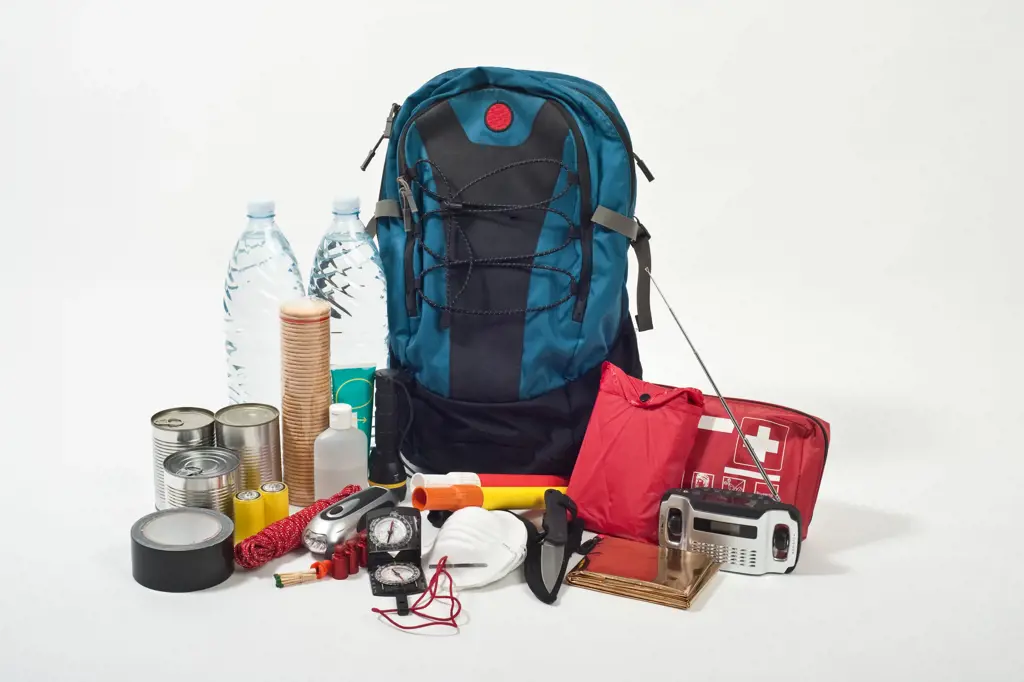
Hurricanes are powerful and destructive storms that can cause massive power outages in their wake. When a hurricane is approaching, it is common for residents in affected areas to evacuate to safer locations. During these evacuations, there is always a risk of losing power, as electricity infrastructure may be damaged by the storm. To ensure that you can stay connected in case of a power loss during a hurricane evacuation, it is a good idea to bring extra batteries and a portable phone charger.
Extra batteries and a portable phone charger are essential items to have during a hurricane evacuation, as they can help keep your devices powered and allow you to stay connected to vital information and loved ones. In the event of a power outage, it is important to have a way to charge your phone, as it can be a lifeline for communication and accessing important resources.
When choosing extra batteries and a portable phone charger, it is important to consider their capacity and compatibility with your devices. Look for batteries and chargers that are capable of providing a sufficient amount of power to keep your devices running. It is also advisable to opt for portable chargers that have multiple ports, so you can charge multiple devices at once.
In addition to extra batteries and a portable phone charger, it is also helpful to have a backup power source, such as a power bank or a generator. These devices can provide a longer-lasting source of power during a power outage, allowing you to recharge your phone and other essential devices multiple times.
During a hurricane evacuation, it is important to conserve power and use your devices sparingly. Keep in mind that the more you use your phone or other devices, the faster their batteries will drain. Use power-saving features, such as reducing screen brightness and disabling unnecessary apps and notifications, to extend your device's battery life.
To further conserve power, it is also a good idea to turn off non-essential features and functions on your phone. For example, disabling Wi-Fi and Bluetooth when not in use can help conserve battery life. Additionally, minimizing your use of power-hungry apps, such as games and streaming services, can help prolong your device's battery life.
During a hurricane evacuation, it is always better to be over-prepared than under-prepared. Bringing extra batteries and a portable phone charger can provide you with a lifeline in case of a power outage. By ensuring that your devices remain powered, you can stay connected to vital information and loved ones during this challenging time.
In conclusion, it is highly advisable to bring extra batteries and a portable phone charger during a hurricane evacuation. These items can help ensure that you can stay connected and access important information in the event of a power outage. However, it is also important to conserve power and use your devices sparingly during a power outage. By following these guidelines, you can be better prepared for the challenges of a hurricane evacuation.
Essential Items for Packing a Baby's Suitcase for a Cruise
You may want to see also

What clothing and personal hygiene items should I include in my evacuation packing list for a hurricane?
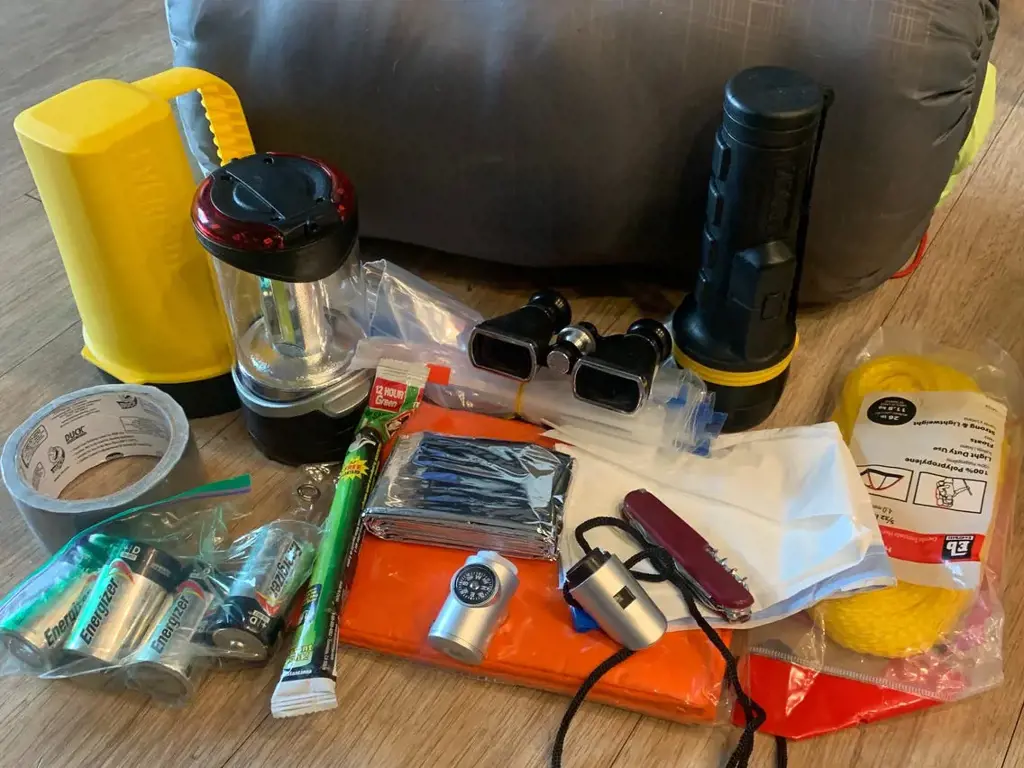
When preparing for a hurricane, it's important to have a well-stocked evacuation packing list to ensure that you have all necessary clothing and personal hygiene items. This will ensure your comfort and hygiene during an evacuation, which can often be a stressful and uncertain time.
Here are some essential items to include in your evacuation packing list for a hurricane:
Clothing:
- Several changes of clothes: Pack enough clothes to last for at least a week, including underwear, socks, and comfortable t-shirts or tops.
- Outerwear: Include a lightweight jacket or hoodie, as well as a raincoat or poncho to protect you from the elements.
- Shoes: Pack sturdy shoes or boots that can withstand wet and muddy conditions.
- Sleepwear: Don't forget to include comfortable pajamas or sleepwear.
- Swimwear: If you're evacuating to an area with access to a pool or beach, pack swimwear for relaxation or exercise.
- Hat and sunglasses: These items will protect you from the sun during outdoor activities.
Personal hygiene items:
- Toiletries: Include travel-sized toiletries such as shampoo, conditioner, soap, toothpaste, and a toothbrush. Opt for unscented options to minimize attracting bugs or animals.
- Toilet paper: Pack a few rolls of toilet paper to ensure you have an adequate supply, as it may not be readily available at evacuation shelters.
- Hand sanitizer: It's crucial to have hand sanitizer to maintain good hygiene, especially in situations where soap and water may not be readily available.
- Feminine hygiene products: If applicable, make sure to pack an ample supply of tampons, pads, or other menstrual products.
- Prescription medications: If you take any prescription medications, make sure to pack a sufficient supply to last you for the duration of the evacuation.
Miscellaneous items:
- Towels: Pack a few towels for personal use or to dry off after taking showers or swimming.
- Bedding: If you're staying in a temporary shelter, pack a sleeping bag or blankets to ensure you have a comfortable sleeping arrangement.
- Laundry supplies: Include a small detergent and a clothesline if you anticipate the need to do laundry during the evacuation.
- Personal documents: Remember to bring important documents such as identification, insurance papers, and any necessary medical records.
- Entertainment: Pack books, magazines, or other forms of entertainment to keep yourself occupied during the evacuation.
It's important to pack these items in a waterproof or water-resistant bag or suitcase to protect your belongings from water damage. Additionally, make sure to check expiration dates on all items, such as medications and toiletries, and replace them if necessary.
Remember that the specific items you need may vary based on your individual needs and preferences. Consider any specific medical or dietary requirements, as well as the climate and duration of the evacuation, when packing your personal hygiene and clothing items. It's always better to be overprepared than underprepared, so take the time to create a comprehensive evacuation packing list to ensure your safety and well-being during a hurricane.
Essential Packing List for Visiting New Orleans in October
You may want to see also
Frequently asked questions
When preparing for a hurricane evacuation, it is important to pack essential items that will help you stay safe and comfortable. These items include a battery-powered radio or weather radio, extra batteries, flashlights, a first aid kit, non-perishable food items, a manual can opener, bottles of water, a change of clothes, toiletries, prescription medications, important documents (such as identification and insurance papers), and cash.
Absolutely! It is important to include emergency supplies for your pets in your evacuation plans. These supplies may include enough pet food and water to last for a few days, a leash and collar, a pet carrier or crate, any necessary medications, copies of veterinary records, and comfort items such as blankets or toys. It is also a good idea to have a plan in place for where you will take your pets during an evacuation, such as a pet-friendly hotel or a designated pet shelter.
In addition to the essentials mentioned earlier, it may be helpful to pack extra blankets or sleeping bags, extra clothing and shoes, personal hygiene items, a manual can opener, disposable plates and utensils, a portable phone charger, a spare set of car keys, a road map, and a small toolkit. It may also be wise to pack a few comfort items, such as books, games, or puzzles, to help pass the time during the evacuation.





